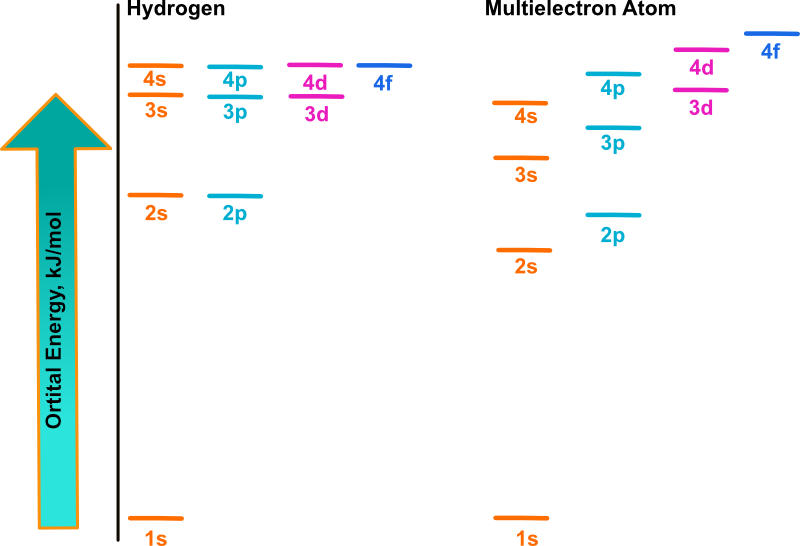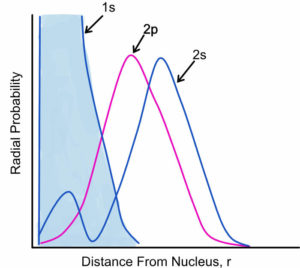The energy of the electron in the hydrogen atom is only dependent on the principle quantum number, n. The subshells and orbitals all have the same energy as n. This is not the case for a multielectron atom as shown in the figure below. A multielectron atom has electron repulsions and the energy of each electron will depend on both n and l.
The orbitals within a shell of a multielectron atom have different energies. In addition to repulsions between the electrons, there are attractions between the electrons and the positively charged nucleus. One important factor is the repulsion of outer-shell electrons by the inner-shell electrons which push the outer-shell electrons further away from the nucleus. Some of the attraction between the nucleus and the outer-shell electrons is diminished resulting in the outer shell electron not experiencing the full nuclear charge. In other words, the inner electrons shield the outer electrons from the nucleus. The nuclear charge the electron actually feels is much lower than the actual nuclear charge. This is called the effective nuclear charge, Zeff and it is lower than the actual nuclear charge, Zactual. The term, S, is the screening constant and is positive. It represents the nuclear charge that screens the valence electrons by the other electrons in the atom. Generally, the value of S is close to the number of core electrons.
For example, looking at the magnesium atom, we see its electron configuration is [Ne] 3s2. There are 10 core electrons and 2 valence electrons. The value of S for one 3s electron is equal to +10 and the nuclear charge is +12 and Zeff = 12 – 10 = +2. The actual value of Zeff for a 3s electron in magnesium is +2.85. This is because a 3s electron has a small probability of being closer to the nucleus in the space of the core electrons. The value of S is changed from +10 to +9.15. There are other more complex ways to determine the value of S, but our simple model allows us to see the trends. The effective nuclear charge, Zeff, increases going across a period and stays fairly constant when going down a group on the periodic table. For example, lithium would have a smaller Zeff than boron.
Electron shielding leads to energy differences among orbitals within a shell due to the shapes of the orbitals as discussed above. For example, an electron in a 2s orbital is able to get closer to the nucleus than an electron in a 2p orbital. This means the electron in the 2s orbital is held more tightly to the nucleus and is less energetic than the electron in the 2p orbital which has a node at the nucleus. The 2s electron is able to penetrate closer to the nucleus than the 2p electron.
In a shell, the energies of the subshells are s < p < d < f with s having the lower energy and f with the highest energy.
Back to Electronic Structure of Atoms
Back to General Chemistry 1 Study Guides
Back to Home Page


